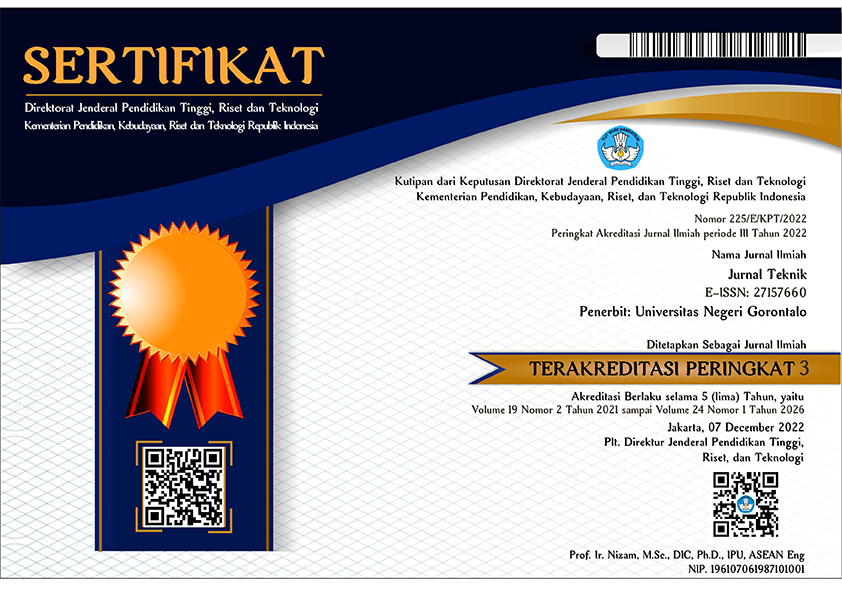Potential Soil Lateral Spreading and Settlement Induced Liquefaction in Indramayu Area
Abstract
An earthquake that had occurred in the Indramayu area in 1847 caused buildings and facilities to collapse, lives were lost, gaps 1-2 feet wide formed in the ground, all buildings in the fort area were severely damaged and could not be rehabited. Based on simulations and evaluations of previous research results in the same area, the source of the damaging earthquake is likely to originate from a shallow earthquake source currently referred to as the Baribis Fault Segment. This study aims to establish a relationship between past earthquake disasters and the potential for their occurrence in the future with the same earthquake source. In this research, we used data from field tests in the form of standard penetration test (SPT) values at 4 technical drilling points, as well as cone penetration test (CPTu) results at 10 test points and CPT results at 13 test points. The three results from the field tests are used in physical and mechanical analysis, as well as safety factors against liquefaction using different PGA value approaches, and the values of these safety factors are considered in estimating potential soil lateral spreading and settlement. The results of the analysis showed that sand sediment layer (fluvial and beach ridges) and sandy sediment layer (delta front silty sand) in the study area had the potential against liquefaction with specific soil settlement and lateral spreading values, depending on PGA values. The highest potential value soil settlement against liquefaction is 0.301 m, while the highest lateral spreading potential of the soil is 0.645 m.
Downloads
References
Bardet, J. P., Tobita, T., Mace, N. & Hua, J. (2002). Regional modeling of liquefaction-induced ground deformation. Earthquake Spectra, 18, 19-46. doi: 10.1193/1.1463409
Bray, J. D. & Dashti, S. (2014). Liquefaction-induced building movements. Bulletin of Earthquake Engineering, 12, 1129-1156. doi: 10.1007/s10518-014-9619-8
Boulanger, R. W. & Idriss, I. M. (2014). CPT and SPT Based Liquefaction Triggering Procedures. Department of Civil and Environmental Engineering. University of California.
Buana, T. W., Hermawan, W., Rahdiana, R. N., Widyaningrum, R., Wahyudin, Hasibuan, G., Wiyono, & Sollu, W. P. (2019). Atlas of The Indonesia Liquefaction Susceptible Zone. Geological Agency, Bandung.
Cubrinovski, M & Ishihara, K. (2004). Simplified method for analysis of piles undergoing lateral spreading in liquefied soils. Soils and Foundations, 44, 119-133. https://doi.org/10.3208/sandf.44.5_119
Elgamal, A., Lu, J., & Yang, Z. (2005). Liquefaction-induced settlement of shallow foundations and remediation: 3D numerical simulation. Journal of Earthquake Engineering, 9, 17–45. https://doi.org/10.1142/S136324690500216X
Irsyam, M., Widiyantoro, S., Natawidjaja, D. H., Meilano, I., Rudiyanto, A., Hidayati, S., Triyoso, W., Hanifa, N. R., Djarwadi, D., Faisal, L., & Sunarjito. (2017). Map of Indonesia's Earthquake Sources and Hazards in 2017. Center for Research and Development of Housing. Research and Development Agency. Ministry of Public Housing and Works Republic Indonesia.
Ishihara, K. & Yoshimine, M. (1992). Evaluation of settlement in sand deposits following liquefaction during earthquakes. Soil and Foundations, 32, 173-188. https://doi.org/10.3208/sandf1972.32.173
Knappett, J. A. and Madabhushi, S. P. G. (2008): Liquefaction induced settlement of pile groups in liquefied and laterally spreading soils. Journal of Geotechnical and Geoenvironmental Engineering, 134, 1609-1618. https://doi.org/10.1061/(ASCE)1090-0241(2008)134:11(1609)
Nguyen, N., Griffin, J., Cipta, A., & Cummins, P. R. (2015). Indonesia’s Historical Earthquakes: Modelled Examples for Improving the National Hazard Map. Record 2015/23. Geoscience Australia, Canberra. http://dx.doi.org/10.11636/Record.2015.023
Rimbaman, I. (1992). The Role of Sea-level Changes on The Coastal Environment of Northern West Java (Case Study of Eretan, Losarang and Indramayu). Journal of Southeast Asian Earth Sciences, 7, 71-77. https://doi.org/10.1016/0743-9547(92)90017-6
Sani, R. A. (2019). Study of Liquefaction Potential Induced Ground Settlement and Lateral Spreading in Lower Cimanuk Catchment Area, Indramayu Regency, West Java Province. Master’s Program Thesis, Bandung Technological Institute.
Sani, R. A., Soebowo, E., Fikri, A. M. & Sadisun, I. A. (2020). Engineering characteristics of quaternary sediment related to potential geological hazards in the lower Cimanuk catchment area. Journal of Environment and Geological Hazards, 11, 161-173. http://dx.doi.org/10.34126/jlbg.v11i3.294
Sani, R. A., Soebowo, E., & Sadisun, I. A. (2022). Quarternary sediment facies induced liquefaction potential in Cimanuk catchment area, indramayu, west java. Journal of Technology, 15, 110-117. https://doi.org/10.34151/jurtek.v15i2.3158
Shahien, M. M. (1998). Settlement of Structures on Granular Soils Subjected to Static and Earthquake Loads. Ph.D. Thesis, University of Illinois at Urbana-Champaign, Urbana, IL.
SNI 1726:2019 about Earthquake Resistance Planning Procedures for Building and Non-Building Structures.
Tjia, H. D., Asikin, S., & Atmadja, R. S. (1968). Coastal accretion in western Indonesia, Bulletin of National Institute of Geology and Mining, 1, 15-45.
Tokimatsu, K. & Asaka, Y. (1998). Effects of liquefaction-induced ground displacements on pile performance in the 1995 Hyogoken-Nambu earthquake. Soils and Foundations, 38, 163-177. https://doi.org/10.3208/sandf.38.Special_163
Xu, L. Y., Cai, F., Wang, G. X., Chen, G.X., & Li Y. Y. (2017). Nonlinear analysis of single reinforced concrete piles subjected to lateral loading. KSCE Journal of Civil Engineering, 21, 2622-2633. https://doi.org/10.1007/s12205-017-1010-2
Xu, L. Y., Song, C. X., Chen, W. Y., Cai, F., Li, Y. Y., & Chen, G. X. (2021). Liquefaction-induced settlement of the pile group under vertical and horizontal ground motions. Soil Dynamics and Earthquake Engineering, 144, 1-13. https://doi.org/10.1016/j.soildyn.2021.106709
Zhang, G., Robertson, P. K., & Brachman R. W. I. (2002). Estimating liquefaction-induced ground settlement from cpt for level ground. Canadian Geotechnical Journal, 39, 1168-1180. DOI: 10.1139/t02-047
Zhang, G., Robertson, P. K., & Brachman R. W. I. (2004). Estimating liquefaction-induced lateral displacement using the standard penetration test or cone penetration test. Journal of Geotechnical and Geoenvironmental Engineering, 130, 861-871. doi:10.1061/(ASCE)1090-0241(2004)130:8(861)
Copyright (c) 2025 Rifki Asrul Sani, Eko Soebowo, Imam Ahmad Sadisun (Author)

This work is licensed under a Creative Commons Attribution-ShareAlike 4.0 International License.













